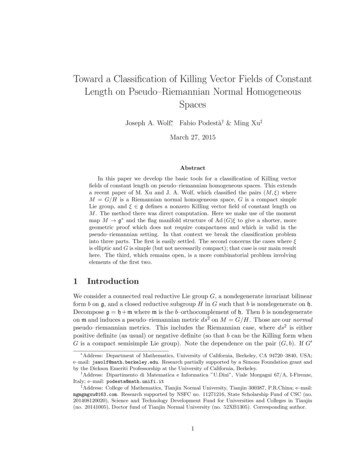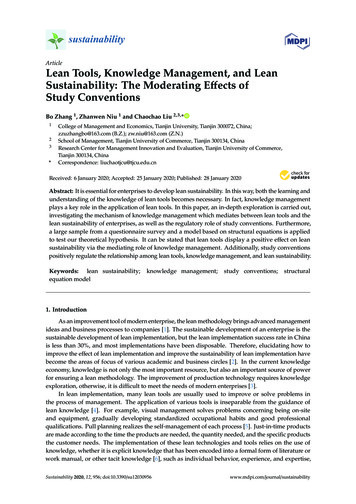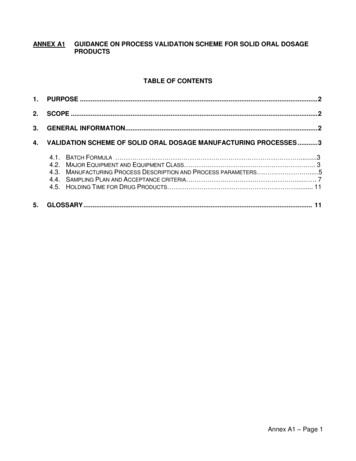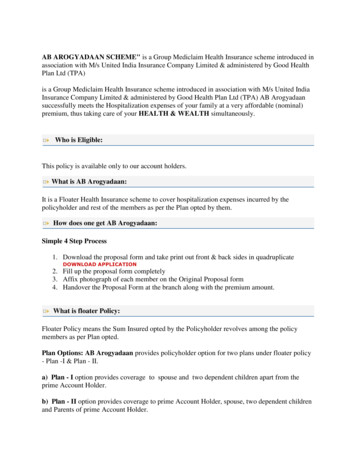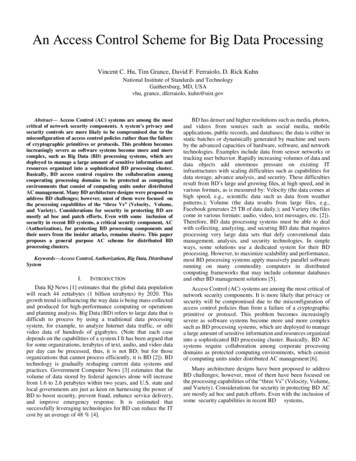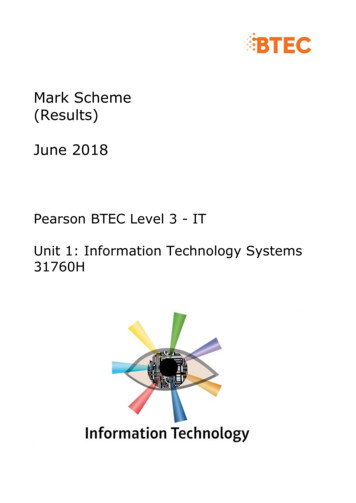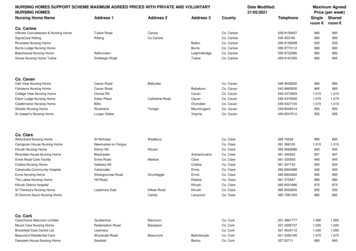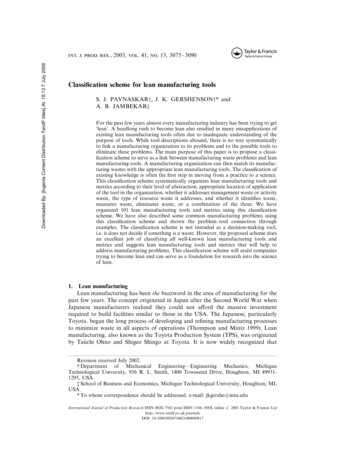
Transcription
Downloaded By: [Ingenta Content Distribution TandF titles] At: 15:13 7 July 2008int. j. prod. res., 2003, vol. 41, no. 13, 3075–3090Classification scheme for lean manufacturing toolsS. J. PAVNASKARy, J. K. GERSHENSONy* andA. B. JAMBEKARzFor the past few years almost every manufacturing industry has been trying to get‘lean’. A headlong rush to become lean also resulted in many misapplications ofexisting lean manufacturing tools often due to inadequate understanding of thepurpose of tools. While tool descriptions abound, there is no way systematicallyto link a manufacturing organization to its problems and to the possible tools toeliminate these problems. The main purpose of this paper is to propose a classification scheme to serve as a link between manufacturing waste problems and leanmanufacturing tools. A manufacturing organization can then match its manufacturing wastes with the appropriate lean manufacturing tools. The classification ofexisting knowledge is often the first step in moving from a practice to a science.This classification scheme systematically organizes lean manufacturing tools andmetrics according to their level of abstraction, appropriate location of applicationof the tool in the organization, whether it addresses management waste or activitywaste, the type of resource waste it addresses, and whether it identifies waste,measures waste, eliminates waste, or a combination of the three. We haveorganized 101 lean manufacturing tools and metrics using this classificationscheme. We have also described some common manufacturing problems usingthis classification scheme and shown the problem–tool connection throughexamples. The classification scheme is not intended as a decision-making tool,i.e. it does not decide if something is a waste. However, the proposed scheme doesan excellent job of classifying all well-known lean manufacturing tools andmetrics and suggests lean manufacturing tools and metrics that will help toaddress manufacturing problems. This classification scheme will assist companiestrying to become lean and can serve as a foundation for research into the scienceof lean.1. Lean manufacturingLean manufacturing has been the buzzword in the area of manufacturing for thepast few years. The concept originated in Japan after the Second World War whenJapanese manufacturers realized they could not afford the massive investmentrequired to build facilities similar to those in the USA. The Japanese, particularlyToyota, began the long process of developing and refining manufacturing processesto minimize waste in all aspects of operations (Thompson and Mintz 1999). Leanmanufacturing, also known as the Toyota Production System (TPS), was originatedby Taiichi Ohno and Shigeo Shingo at Toyota. It is now widely recognized thatRevision received July 2002.{ Department of Mechanical Engineering—Engineering Mechanics, MichiganTechnological University, 936 R. L. Smith, 1400 Townsend Drive, Houghton, MI 499311295, USA.{ School of Business and Economics, Michigan Technological University, Houghton, MI,USA.* To whom correspondence should be addressed. e-mail: jkgershe@mtu.eduInternational Journal of Production Research ISSN 0020–7543 print/ISSN 1366–588X online # 2003 Taylor & Francis Ltdhttp://www.tandf.co.uk/journalsDOI: 10.1080/0020754021000049817
Downloaded By: [Ingenta Content Distribution TandF titles] At: 15:13 7 July 20083076S. J. Pavnaskar et al.organizations that have mastered lean manufacturing methods have substantial costand quality advantages over those still practising traditional mass production(Fleischer and Liker 1997).The goal of lean manufacturing is to reduce the waste in human effort, inventory,time to market and manufacturing space to become highly responsive to customerdemand while producing world-class quality products in the most efficient and economical manner (Todd 2000). Shigeo Shingo (1992) strongly advocated the elimination of waste and put forth the idea, ‘don’t accept waste as unavoidable’. The basis oflean manufacturing is the elimination of waste. Russell and Taylor (1999) definewaste as ‘anything other than the minimum amount of equipment, materials,parts, space, and time that are essential to add value to the product’. Waste takesmany forms and can be found at any time and in any place. There is the waste ofcomplexity, labour (the unnecessary movement of people), overproduction, space,energy, defects, materials, time and transport (Nicholas 1998, Boeing 2000).Waste uses resources but does not add value to the product (SearchManufacturing 2000). Lean manufacturing combines the best features of bothmass production and craft production: the ability to reduce costs per unit anddramatically improve quality while at the same time providing an ever widerrange of products and more challenging work (Womack et al. 1990).The benefits of lean manufacturing are evident in factories across the world.Companies report improved product quality, reductions in cycle time, reducedwork in progress (WIP), improved on-time deliveries, improved net income,decreased costs, improved utilization of labour, reduction in inventories, quickerreturn on inventory investment, higher levels of production, increased flexibility,improved space utilization, reduction in tool investment, a better utilization ofmachinery stronger job focus and better skills enhancement. The following overallperformance gains have been attributed to the lean manufacturing concepts andtools (CITEC 2000, Connstep 2000, Zimmer 2000).Defects reduced by 20% per year, with zero defects performance possible.Delivery lead times reduced by more than 75%.On time delivery improved to more than 99%.Productivity (sales per employee) increases of 15–35% per year.Inventory reductions of more than 75%.Return on assets improvement of more than 100%.Improvements of 10% or more on direct labour utilization.Improvements of up to 50% in indirect labour utilization.50% or greater increases in capacity in current facilities.80% reduction in floor space.50% improvement in quality.95% machine availability.80–90% reduction in changeovers.60% reduction in cycle times.Lean manufacturing uses tools such as kaizen, one-piece flow, cellular manufacturing, synchronous manufacturing, inventory management, pokayoke, standardizedwork, workplace organization and scrap reduction to reduce manufacturing waste(Russell and Taylor 1999). There exists a plethora of different tools and techniquesdeveloped for different purposes and waste elimination or reduction (Green andDick 2001). Tools exist with multiple names, some of them overlap with other
Downloaded By: [Ingenta Content Distribution TandF titles] At: 15:13 7 July 2008Classification scheme for lean manufacturing tools3077tools, and a particular tool might even have a different method of implementationproposed by different researchers. For example, value stream mapping is alsoreferred to as process mapping. Hence, there is a need systematically to classifyand organize these tools in a way that will make information about the tools readilyavailable and will remove ambiguities in definition, purpose, and implementation ofthe tools. Applying the tools and metrics is difficult due to this confusion and thelack of a systematic classification of their applications (Gateway2Lean 2001).Misapplications of lean manufacturing tools and techniques have also been reportedby companies in their pursuit to become lean (Factorylogic, discussion with seniorconsultants at the company, 2001). The misapplications are of three types: use of thewrong tool to solve a problem, use of a single tool to solve all of the problems anduse of all tools (same set of tools) on each problem.The misapplication of a lean manufacturing tool may result in the additionalwastage of resources such as time and money. It may also result in reduced employeeconfidence in the lean philosophy. One such example is from a small manufacturerstruggling with on-time deliveries due to a bottleneck in a manual operation. Itimplemented 5S, a tool it had been implementing all over the plant, thinking thiswould help solve their problems. They focused on taping, labelling, signs and othervisual controls. Instead of gaining improvements, the cells became even more erraticin their cycle times, resulting in scepticism about lean in the company (Factorylogic,discussion with senior consultants at the company, 2001). The lean manufacturingclassification scheme proposed in this research is intended to minimize the misapplication of tools and metrics.2. Classification in manufacturingWith such convincing advantages to lean manufacturing, it is no wonder thatan increasing number of companies are trying to become lean. However, becominglean is not as easy as it seems. It requires total dedication from personnel, carefulplanning, strong leadership and adequate knowledge about the lean manufacturingphilosophy, tools and techniques. A classification or systematic organization of leanmanufacturing and lean manufacturing tools and techniques will be of great help fororganizations becoming lean. In the past, classification schemes have been presentedto classify manufacturing problems, manufacturing wastes and even lean manufacturing tools. Our work goes beyond these classification schemes but we took time toconsider the functionality of these schemes. Therefore, we present a brief overview ofthese areas.2.1. Manufacturing problemsThere are many different types of manufacturing problems within each componentof a manufacturing organization. Manufacturing problems can be of numerous types:personnel, quality, equipment, etc. Casti (1987) showed that each manufacturing problem exists at a certain hierarchical level (table 1), the lowest being raw materials, thehighest being values. Further, he labelled each problem as a design, production ordistribution problem. Finally, Casti showed that each problem has associated with itone or more characteristic, foundational system concepts, as he refers to them, thatlend the problem its characteristic system flavour. These foundational system conceptsare: flexibility/adaptability, complexity, efficiency/optimality, vulnerability/resilience,reliability, uncertainty/fuzziness, self-organization/replication and performance.
Downloaded By: [Ingenta Content Distribution TandF titles] At: 15:13 7 July 20083078S. J. Pavnaskar et al.Hierarchical levelIXVIIIVIIVIVIVIIIIIIValuesWorld industryManufactured goodsIndustryLocal industryFinished productComponentsPartsMaterialsTable 1.Functional levelDesignProductionMarketingConceptual eliabilityUncertaintySelf organizationPerformanceManufacturing system taxonomy (Casti 1987).Putting the hierarchical, design–production–distribution and system concepts labelstogether supplies the basis for a classification scheme for manufacturing problems.This classification encompasses a large scope. First, the entire world outside theplant is included. In addition, beyond production, design and marketing areincluded. Additionally, conceptual level concerns outside of the realm of waste areincluded. Of course, we intend to classify more than just a manufacturing organization. We must make sure, however, that our classification scheme allows for theinclusion of hierarchical levels I–V.2.2. Manufacturing wasteIdentifying and classifying manufacturing problems is of significant value to amanufacturing organization. True advances, however, come from exposing manufacturing wastes. Shingo and Ohno (Shingo 1992) identified seven different types ofmanufacturing wastes: overproduction, waiting time, transport, inventory, motion,defects and processing. Within the context of lean manufacturing, many researchershave extended the list of manufacturing wastes to encompass many other wastesmentioned previously (Womack et al. 1990, Liker 1998). Imai (1986) lists nine wastesin production: of rejects, in design, in WIP, in the first phase of production, inmotion, in management, in manpower, in facilities and in expenses. Lists of wastesabound; classifications of wastes by where, when, how and why they occur do not yetexist. While exposing and classifying manufacturing, wastes can be the first step inimproving a manufacturing organization. Identification is useless if the waste cannotbe eliminated. It is therefore important to apply the correct tools, lean manufacturing tools, to eliminate manufacturing waste.2.3. Lean manufacturing toolsOver the years, many lean manufacturing tools and techniques have been developed and every day new ones are proposed (Schonberger 1982, Dillon et al. 1985,Womack et al. 1990, Barker 1994, Liker et al. 1995, Cusumano and Nobeoka 1998,Liker 1998, Feld 2000, Taylor and Brunt 2001). With such a plethora of tools andtechniques it is important and helpful to organize them into a systematic and logicalmanner. A systematic organization of these tools will help in their effective implementation of tools or for getting lean. For example, an organization or listing oftools according to the resource they are applied to will ease the process of toolselection for improvement. Taylor and Brunt (2001) developed a simple correlation
Downloaded By: [Ingenta Content Distribution TandF titles] At: 15:13 7 July 2008Classification scheme for lean manufacturing tools3079matrix that relates seven different value stream mapping tools—process activitymapping, supply chain response matrix, production variety funnel, quality filtermapping, demand amplification mapping, decision point analysis, and physicalstructure volume and value—to the seven basic types of wastes identified by Ohnoand Shingo. The correlation matrix is used to select the appropriate value streammapping tools to eliminate a particular waste. Taylor and Brunt also identified arange of frequently encountered key processes in an organization; 12 value streamwastes within a component and assembly production, seven work envir
existing lean manufacturing tools often due to inadequate understanding of the purpose of tools. While tool descriptions abound, there is no way systematically to link a manufacturing organization to its problems and to the possible tools to eliminate these problems. The main purpose of this paper is to propose a classi- fication scheme to serve as a link between manufacturing waste problems .
